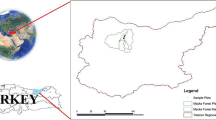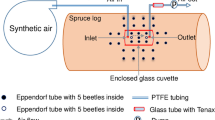Abstract
The influence of the aggregation inhibitors verbenone and ipsdienol on the response of western pine beetle,Dendroctonus brevicomis, to attractive host trees was investigated. Paired ponderosa pine trees (Pinus ponderosa) were baited with aggregation semiochemicals to stimulate mass attack. One tree in each pair received an inhibitor treatment consisting of five sets of two verbenone and two ipsdienol dispensers spaced 1 m apart vertically along the tree bole. Beetle landing was monitored with sticky traps on the tree bole, and attack density was assessed from bark samples removed four or seven days after baiting. The inhibitor treatment resulted in a significant reduction of both the numbers of beetles landing on trees and the density of attacking beetles compared to control trees (without inhibitors). The ratios of beetle landing density to attacking density were not different between inhibitor-treated and control trees, nor were the vertical distributions of beetles landing or attacking, suggesting that beetle behavior was primarily influenced at a longer range, prior to landing on the tree. Although the application of verbenone and ipsdienol did not preventD. brevicomis from attacking baited trees, our results suggest that when applied to unattacked (and unbaited) trees, their effectiveness at reducing the attack pressure might allow trees having a certain amount of resistance to survive attack by pioneer beetles.
Similar content being viewed by others
References
Anderbrandt, O., Schlyter, F., andLofqvist, J. 1988. Dynamics of tree attack in the bark beetleIps typographus under semi-epidemic conditions, pp. 35–51,in T.L. Payne and H. Saarenmaa (eds.). Integrated Control of Scolytid Bark Beetles. Virginia Polytechnic Institute and State University, Blacksburg, Virginia.
Bedard, W.D., Tilden, P.E., Wood, D.L., Silverstein, R.M., Brownlee, R.G., andRodin, J.O. 1969. Western pine beetle: Field response to its sex pheromone and a synergistic host terpene, myrcene.Science 164:1284–1285.
Bedard, W.D., Tilden, P.E., Lindahl, K.Q., Jr., Wood, D.L., andRauch, P.A. 1980. Effects of verbenone and trans-verbenol on the response ofDendroctonus brevicomis to natural and synthetic attractant in the field.J. Chem. Ecol. 6:997–1013.
Berryman, A.A. 1972. Resistance of conifers to invasion by bark beetle-fungus associations.BioScience 22:598–602.
Berryman, A.A., DeMars, C.J., Jr., andStark, R.W. 1970. Section 4. The development of sampling methods for “within-tree” populations of the western pine beetle, pp. 33–41,in R.W. Stark and D.L. Dahlsten (eds.). Studies on the Population Dynamics of the Western Pine Beetle,Dendroctonus brevicomis LeConte (Coleoptera: Scolytidae). University of California, Division of Agricultural Sciences, Berkeley.
Borden, J.H., Ryker, L.C., Chong, L.J., Pierce, H.D., Johnston, B.D., andOehlschlager, A.C. 1987. Response of the mountain pine beetle,Dendroctonus ponderosae Hopkins (Coleoptera: Scolytidae), to five semiochemicals in British Columbia lodgepole pine forests.Can. J. For. Res. 17:118–128.
Browne, L.E., Wood, D.L., Bedard, W.D., Silverstein, R.M., andWest, J.R. 1979. Quantitative estimates of the western pine beetle attractive pheromone components,exo-brevicomin, frontalin, and myrcene in nature.J. Chem. Ecol. 5:397–414.
Byers, J.A. 1982. Male-specific conversion of the host-plant compound, myrcene, to the pheromone, (+)-ipsdienol, in the bark beetleDendroctonus brevicomis.J. Chem. Ecol. 8:363–371.
Byers, J.A., andWood, D.L. 1980. Interspecific inhibition of the response of the bark beetles,Dendroctonus brevicomis andIps paraconfusus, to their pheromones in the field.J. Chem. Ecol. 6:149–164.
Byers, J.A., Wood, D.L., Craig, J., andHendry, L.B. 1984. Attractive and inhibitory pheromones produced in the bark beetleDendroctonus brevicomis: Regulation of inter- and intraspecific competition.J. Chem. Ecol. 10:861–877.
Coster, J.E., Payne, T.L., Hart, E.R., andEdson, L.J. 1977. Aggregation of the southern pine beetle in response to attractive host trees.Environ. Entomol. 6:725–731.
DeMars, C.J., Jr. 1970. Section 6. Frequency distributions, data transformations, and analysis of variations used in determination of optimum sample size and effort for broods of the western pine beetle, pp. 42–65,in R.W. Stark and D.L. Dahlsten (eds.). Studies on the Population Dynamics of the Western Pine Beetle,Dendroctonus brevicomis LeConte (Coleoptera: Scolytidae). University of California, Division of Agricultural Sciences, Berkeley.
Dudley, C.O. 1971. A sampling design for the egg and first instar larval populations of the western pine beetle,Dendroctonus brevicomis (Coleoptera: Scolytidae).Can. Entomol. 103:1291–1313.
Hodges, J.D., Elam, W.W., Watson, W.F., andNebeker, T.E. 1979. Oleoresin characteristics and susceptibility of four southern pines to southern pine beetle (Coleoptera: Scolytidae) attacks.Can. Entomol. 111:889–896.
Kinzer, G.W., Fentiman, A.F., Jr., Page, T.E., Jr., Foltz, R.L., Vité, J.P., andPitman, G.B. 1969. Bark beetle attractants: Identification, synthesis, and field bioassay of a new compound isolated fromDendroctonus.Nature 221:477–478.
Linit, M.J., andStephen, F.M. 1978. Comparison of methods for estimation of attacking adult populations ofDendroctonus frontalis.J. Econ. Entomol. 71:732–735.
Miller, J.M., andKeen, F.P. 1960. Biology and control of the western pine beetle. U.S. Department of Agriculture Miscellaneous Publication 800.
Minitab, Inc. 1992. Minitab Statistical Software, Standard Version, Release 9.1 for VAX/VMS. Minitab, Inc., State College, Pennsylvania.
Paine, T.D. 1984. Seasonal response of ponderosa pine to inoculation of the mycangial fungi from the western pine beetle.Can. J. Bot. 62:551–555.
Paine, T.D., andHanlon, C.C. 1991. Response ofDendroctonus brevicomis andIps paraconfusus (Coleoptera: Scolytidae) to combinations of synthetic pheromone attractants and inhibitors verbenone and ipsdienol.J. Chem. Ecol. 17:2163–2176.
Paine, T.D., andStephen, F.M. 1988. Induced defenses of loblolly pine,Pinus taeda: Potential impact onDendroctonus frontalis within-tree mortality.Entomol. Exp. Appl. 46:39–46.
Paine, T.D., Stephen, F.M., andCates, R.G. 1988. Phenology of an induced response in loblolly pine following inoculation of fungi associated with the southern pine beetle.Can. J. For. Res. 18:1556–1562.
Payne, T.L., Coster, J.E., Richerson, J.V., Edson, L.J., andHart, E.R. 1978. Field response of the southern pine beetle to behavioral chemicals.Environ. Entomol. 7:578–582.
Payne, T.L., Billings, R.F., Berisford, C.W., Salom, S.M., Grosman, D.M., Dalusky, M.J., andUpton, W.W. 1992. Disruption ofDendroctonus frontalis infestations with an inhibitor pheromone.J. Appl. Entomol. 114:341–347.
Raffa, K.F., andBerryman, A.A. 1983. The role of host plant resistance in the colonization behavior and ecology of bark beetles (Coleoptera: Scolytidae).Ecol. Monogr. 53:27–49.
Renwick, J.A.A., andVité, J.P. 1970. Chemical communication inDendroctonus.Contrib. Boyce Thompson Inst. 24:283–292.
Richerson, J.V., andPayne, T.L. 1979. Effects of bark beetle inhibitors on landing and attack behavior of the southern pine beetle and beetle associates.Environ. Entomol. 8:360–364.
Shore, T.L., Safranyik, L., andLindgren, B.S. 1992. The response of mountain pine beetle to lodgepole pine trees baited with verbenone and exo-brevicomin.J. Chem. Ecol. 18:533–541.
Silverstein, R.M., Brownlee, R.G., Bellas, T.E., Wood, D.L., andBrowne, L.E. 1968. Brevicomin: Principal sex attractant in the frass of female western pine beetle.Science 159:889–891.
Smith, R.H. 1990. Direct control of western pine beetle (Dendroctonus brevicomis LeConte): Review and assessment. United States Department of Agriculture Forest Service, Pacific Southwest Research Station General Technical Report PSW-121.
Sokal, R.R., andRohlf, F.J. 1981. Biometry, 2nd ed. W.H. Freeman, San Francisco.
Steel, R.G.D., andTorrie, J.H. 1980. Principles and Procedures of Statistics: A Biometrical Approach, 2nd ed. McGraw-Hill, New York.
Stephen, F.M., andDahlsten, D.L. 1976. The temporal and spatial arrival pattern ofDendroctonus brevicomis in ponderosa pine.Can. Entomol. 108:271–282.
Stephen, F.M., andTaha, H.A. 1976. Optimization of sampling effort for within-tree populations of southern pine beetle and its natural enemies.Environ. Entomol. 5:1001–1007.
Stewart, T.E., Plummer, E.L., McCandless, L.L., West, J.R., andSilverstein, R.M. 1977. Determination of enantiomer composition of several bicyclic ketal insect pheromone components.J. Chem. Ecol. 3:27–43.
Tilden, P.E., andBedard, W.D. 1988. Effect of verbenone on response ofDendroctonus brevicomis toexo-brevicomin, frontalin, and myrcene.J. Chem. Ecol. 14:113–122.
Vité, J.P., andPitman, G.B. 1969. Aggregation behavior ofDendroctonus brevicomis in response to synthetic pheromones.J. Insect Physiol. 15:1617–1622.
Wood, D.L. 1972. Selection and colonization of ponderosa pine by bark beetles, pp. 101–117,in H.F. van Emden (ed.). Insect/Plant Relationships. Symposium, Royal Entomological Society, London. No. 6.
Wood, D.L. 1982. The role of pheromones, kairomones, and allomones in the host selection and colonization behavior of bark beetles.Annu. Rev. Entomol. 27:411–416.
Author information
Authors and Affiliations
Rights and permissions
About this article
Cite this article
Bertram, S.L., Paine, T.D. Influence of aggregation inhibitors (verbenone and ipsidenol) on landing and attack behavior ofDendroctonus brevicomis (Coleoptera: Scolytidae). J Chem Ecol 20, 1617–1629 (1994). https://doi.org/10.1007/BF02059884
Received:
Accepted:
Issue Date:
DOI: https://doi.org/10.1007/BF02059884




